
Charles Messier was a French astronomer. He published an astronomical catalogue consisting of 110 nebulae and star clusters, which came to be known as the Messier objects. Messier's purpose for the catalogue was to help astronomical observers distinguish between permanent and transient visually diffuse objects in the sky.

The Messier objects are a set of 110 astronomical objects catalogued by the French astronomer Charles Messier in his Catalogue des Nébuleuses et des Amas d'Étoiles. Because Messier was only interested in finding comets, he created a list of those non-comet objects that frustrated his hunt for them. The compilation of this list, in collaboration with his assistant Pierre Méchain, is known as the Messier catalogue. This catalogue of objects is one of the most famous lists of astronomical objects, and many Messier objects are still referenced by their Messier numbers. The catalogue includes most of the astronomical deep-sky objects that can easily be observed from Earth's Northern Hemisphere; many Messier objects are popular targets for amateur astronomers.

Messier 13 or M13, also designated NGC 6205 and sometimes called the Great Globular Cluster in Hercules or the Hercules Globular Cluster, is a globular cluster of several hundred thousand stars in the constellation of Hercules.

The Pinwheel Galaxy is a face-on spiral galaxy 21 million light-years away from Earth in the constellation Ursa Major. It was discovered by Pierre Méchain in 1781 and was communicated that year to Charles Messier, who verified its position for inclusion in the Messier Catalogue as one of its final entries.

The Notwist are a German indie rock band. Formed in 1989, the band moved through several musical incarnations, despite maintaining a relatively stable line-up. While their early records moved through heavy metal into dark indie rock, their recent efforts for which they have received the most attention have been strongly influenced by the electronica scene, along with the other groups on the record label, Morr Music.

Messier 7 or M7, also designated NGC 6475 and sometimes known as the Ptolemy Cluster, is an open cluster of stars in the constellation of Scorpius. The cluster is easily detectable with the naked eye, close to the "stinger" of Scorpius. With a declination of −34.8°, it is the southernmost Messier object.
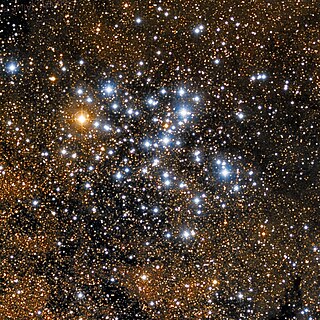
The Butterfly Cluster is an open cluster of stars in the southern constellation of Scorpius. Its name derives from the vague resemblance of its shape to a butterfly. The Trumpler classification of II 3 r encodes it is rich in stars, ranks II out of IV for disparateness and greatly mixes bright with faint components. It is 3.5° to the northwest of Messier 7, both north of the tail of Scorpius.
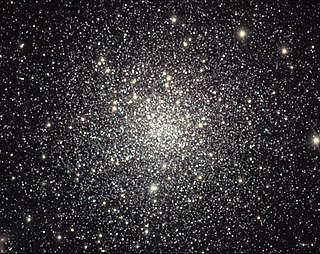
Messier 12 or M 12 is a globular cluster in the constellation of Ophiuchus. It was discovered by the French astronomer Charles Messier on May 30, 1764, who described it as a "nebula without stars". In dark conditions this cluster can be faintly seen with a pair of binoculars. Resolving the stellar components requires a telescope with an aperture of 8 in (20 cm) or greater. In a 10 in (25 cm) scope, the granular core shows a diameter of 3′ (arcminutes) surrounded by a 10′ halo of stars.

The Small Sagittarius Star Cloud is a star cloud in the constellation of Sagittarius approximately 600 light years wide, which was catalogued by Charles Messier in 1764. It should not be confused with the nearby Large Sagittarius Star Cloud which lies about 10° to the south.
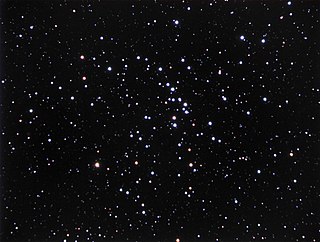
Messier 48 or M48, also known as NGC 2548, is an open cluster of stars in the equatorial constellation of Hydra. It sits near Hydra's westernmost limit with Monoceros, about 18° 34′ to the east and slightly south of Hydra's brightest star, Alphard. This grouping was discovered by Charles Messier in 1771, but there is no cluster precisely where Messier indicated; he made an error, as he did with M47. The value that he gave for the right ascension matches, however, his declination is off by five degrees. Credit for discovery is sometimes given instead to Caroline Herschel in 1783. Her nephew John Herschel described it as, "a superb cluster which fills the whole field; stars of 9th and 10th to the 13th magnitude – and none below, but the whole ground of the sky on which it stands is singularly dotted over with infinitely minute points".
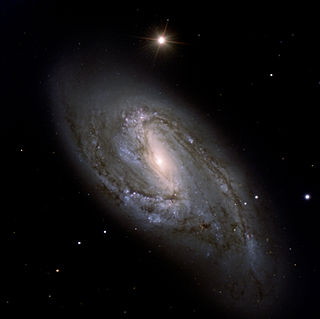
Messier 66 or M66, also known as NGC 3627, is an intermediate spiral galaxy in the southern, equatorial half of Leo. It was discovered by French astronomer Charles Messier on 1 March 1780, who described it as "very long and very faint". This galaxy is a member of a small group of galaxies that includes M65 and NGC 3628, known as the Leo Triplet or the M66 Group. M65 and M66 are a common object for amateur astronomic observation, being separated by only 20′.
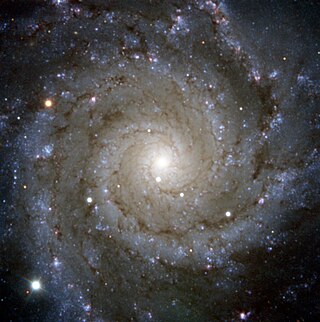
Messier 74 is a large spiral galaxy in the equatorial constellation Pisces. It is about 32 million light-years away from Earth. The galaxy contains two clearly defined spiral arms and is therefore used as an archetypal example of a grand design spiral galaxy. The galaxy's low surface brightness makes it the most difficult Messier object for amateur astronomers to observe. Its relatively large angular size and the galaxy's face-on orientation make it an ideal object for professional astronomers who want to study spiral arm structure and spiral density waves. It is estimated that M74 hosts about 100 billion stars.

Messier 77 (M77), also known as NGC 1068 or the Squid Galaxy, is a barred spiral galaxy in the constellation Cetus. It is about 47 million light-years (14 Mpc) away from Earth. Messier 77 was discovered by Pierre Méchain in 1780, who originally described it as a nebula. Méchain then communicated his discovery to Charles Messier, who subsequently listed the object in his catalog. Both Messier and William Herschel described this galaxy as a star cluster. Today, however, the object is known to be a galaxy.

Messier 96 is an intermediate spiral galaxy about 31 million light-years away in the constellation Leo.

The Owl Nebula is a starburst ("planetary") nebula approximately 2,030 light years away in the northern constellation Ursa Major. The estimated age of the Owl Nebula is about 8,000 years. It is approximately circular in cross-section with faint internal structure. It was formed from the outflow of material from the stellar wind of the central star as it evolved along the asymptotic giant branch. The nebula is arranged in three concentric shells/envelopes, with the outermost shell being about 20–30% larger than the inner shell. A mildly owl-like appearance of the nebula is the result of an inner shell that is not circularly symmetric, but instead forms a barrel-like structure aligned at an angle of 45° to the line of sight.

Neon Golden is the fifth studio album by German indie rock band The Notwist. It was released on 14 January 2002 by City Slang.

The Caldwell catalogue is an astronomical catalogue of 109 star clusters, nebulae, and galaxies for observation by amateur astronomers. The list was compiled by Patrick Moore as a complement to the Messier catalogue.

The Devil, You + Me is the sixth studio album by German indie rock band The Notwist. It was released in 2008.
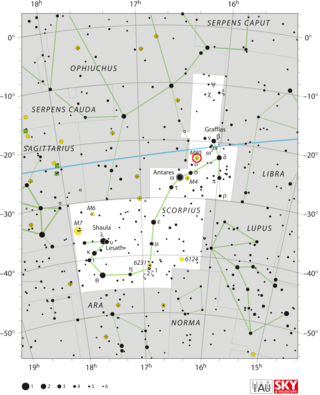
T Scorpii, or Nova Scorpii 1860, was a nova in the globular cluster Messier 80 (M80). It was discovered on 21 May 1860 by Arthur von Auwers at Koenigsberg Observatory and was independently discovered by Norman Pogson on May 28th at Hartwell observatory. It was at magnitude 7.5 at discovery, reaching a maximum of magnitude 6.8, outshining the whole cluster.

Vertigo Days is the ninth studio album by German electronic band The Notwist. It was released on 29 January 2021 by Morr Music.



















